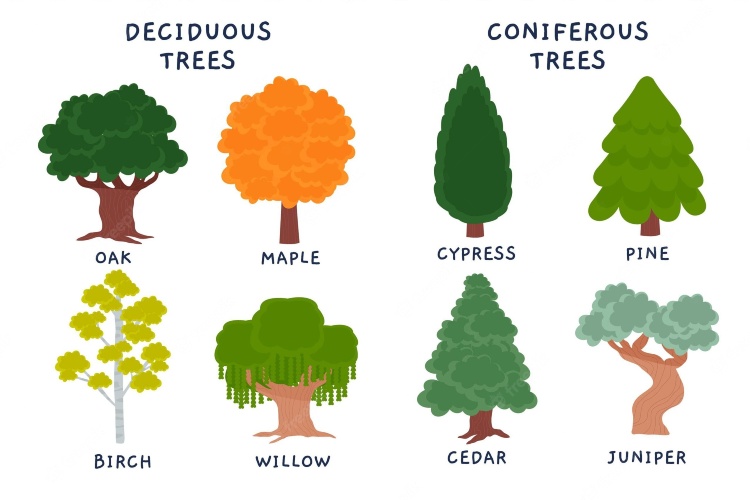|
Getting your Trinity Audio player ready...
|
Deciduous Trees
Deciduous trees shed their leaves in the fall, unlike conifers, which keep their leaves all year round. They are grown for their attractive ornamental properties, such as decorative bark, flowers, colorful foliage, or autumn fruits, and their shape creates height and structure in a garden. Its leaves can develop beautiful colors before they fall in autumn. Most ornamental trees have a single trunk with a lignified trunk, although some varieties, mainly birch, can be bought or grown as “multi-trunked” with two or three trunks, while others have a busy port.
They can also serve a useful purpose in the garden. For example, they can help protect windows with a view, unpleasant views, or create protection from the wind. Trees can also be precious to wildlife by providing nesting sites, singing posts, and birds shelter. Flowering trees attract pollinating insects, while autumn fruits, seeds, and nuts provide food for a wide variety of birds and mammals. In addition, the leaves of deciduous trees can be collected in the fall to form a nutritious mold.
Deciduous trees vary widely in size, shape, and growth pattern, so choosing a suitable variety for your garden is essential. The most common trees are round-headed, spreading, pyramidal, columnar, and weeping trees. Think about the size of the tree and how its shape will affect the space in which you plant it, especially in relation to neighboring homes and buildings.
Types of Deciduous Trees

When choosing deciduous trees for your landscape, be sure to select appropriate varieties for your growing region. While many deciduous trees such as maple, willow, birch, oak, and walnut are tall, several smaller or decorative deciduous trees make great additions to the home landscape. Popular flowering trees include crepe myrtle and redbud. In addition, fruit trees like apples, plums, and peaches are a charming and tasty addition to any garden and are often available in dwarf sizes, perfect for those with limited space.
Most Common Deciduous Trees Names
- Apple Tree
- Cacao Tree
- Peepal Tree (This Tree is Deciduous and Coniferous Both)
- Mango Tree
- Papaya Tree
- Ginkgo Biloba Tree
- Walnut Tree
- Oak Tree
- Mimosa Tree
- Mulberry Tree
- Almond Tree
- Jacaranda Tree (This Tree is Deciduous and Coniferous Both)
- Catalpa Tree
- Bonsai Tree (This Tree is Deciduous and Coniferous Both)
Coniferous Trees
Conifers are a large group of conifers and shrubs with cones. According to the biological classification, conifers form the order Coniferales gymnosperms. Gymnosperms are woody plants that have raw seeds and do not produce flowers. There are 7 families of conifers classified into 67 groups named genera and over 600 living species.
These are cone-shaped conifers; the needle- or scale-shaped leaves are called conifers. Most of the trees that grow in these forest areas are cone-shaped gymnosperms, which means that their seeds are exposed to the hole without an external enclosure in the form of cones. Although nowhere is as rich as warm forests and tropical rainforests, conifers have adjusted well to the unique growing conditions of coniferous forests..
Conifer leaves on trees such as Pine, spruce, and larch have thin leaves that seem like needles, and other coniferous plants such as cypress, juniper, and cedar, have soft scale-like leaves. When those conifers shed foliage, it is short branches that fall, not individual leaves. See Also Deciduous Trees.
Types of Coniferous Trees

Conifers are common types of conifers identified by pine-like needle leaves and seed-producing cones. Most conifer species are evergreen, but some conifers are deciduous and shed their leaves in autumn. In summary, conifers belong to the plant class Coniferophyta. In addition, these trees are gymnosperms, which means that they have cone-shaped seeds. There are more than six hundred species of conifers, divided into eight families.
The most popular species of conifers are Pine such as Scots Pine, Douglas fir, and White Pine. Then there are the fir trees, including evergreen trees such as the Fraser fir, noble fir, and white fir.
It is a challenge to distinguish between the different types of conifers. To distinguish evergreen conifer species, you need to look at the type of needle leaves, cones, bark, and shape of the tree. For example, spruce trees have evergreen foliage that is pointed and sharp, whereas first look similar but have softer needles.
Most Common Coniferous Trees Names
- Coconut Tree
- Dragon Tree
- Peepal Tree
- Breadfruit Tree
- Lemon Tree
- Bonsai Tree (This Tree is Deciduous and Coniferous Both)
- Olive Tree
- Palm Tree
- Jacaranda Tree (This Tree is Deciduous and Coniferous Both)
Wrapping Up
In this post, I explained coniferous & deciduous trees, like their types, common names, and definitions, etc. I hope you enjoyed this post. Thank you…



